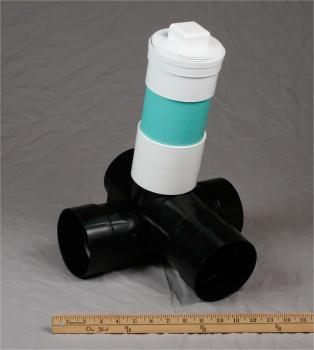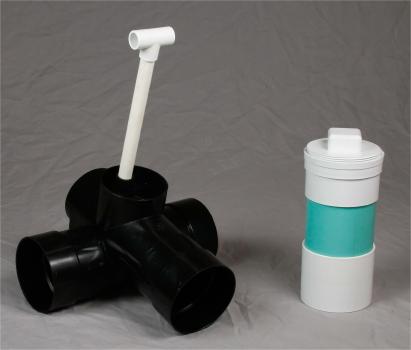Septic effluent valve tee splits 50/50 or 100% one direction
Four inch flow director splitter valve comes complete with adjustment handle, riser, coupler, and four inch threaded access cap. Special staggered hub fittings on the ‘Versa-tee’ will accommodate PVC or ABS pipe in 4 inch diameter in both Sch40 or thin wall SDR35 sewer drain pipe. Note there is a two inch drop in elevation from inlet pipe (base of tee) to two outlet pipes (top of tee) where the effluent flow splits. Effluent flow can be split 50/50 evenly between the two outlet pipes OR you can alternate the flow 100% to one side or the other. Diverter allows one half of your septic system leachfield to go fallow for a few months to revitalize soil, prevent overloading, and reduce the growth of bio-matting. Three director valves will allow splitting flow between four separate leach field lines. Then you have the option of letting 1/4 of leachfield to go dry seasonally. This is not a gate valve. Flow director splitter valve fitting is designed only for gravity flow systems. An internal weir divides the gradual stream from septic tank. Not for use in pressurized pipe, dosing systems with lift station pumps or automatic siphons, steep slopes and long runs (*see details in last paragraph). Use two gate valves and a tee manifold instead of this director valve fitting with 'pressurized' pipe systems. We don't sell gate valves given the extremely wide range of quality, features, and size options. Choose one with a handle that can reach up to the ground surface. Please email service@thenaturalhome.com with any questions or concerns.
Director Valve Kits come as pictured, complete with four inch threaded access cap, riser pipe, coupler, and the adjustment handle. Extension of riser pipe and handle is possible with common PVC pipe. 'Versa-tee' accommodates 4 inch diameter Sch40 or SDR35 pipe and can be used with ABS or PVC since it is not a pressurized fitting.
$107 each with FREE UPS Ground shipping to 48 states. In stock and will ship by the next business day.
In stock


Best practice is to bed valve fitting in at least 6 to 8 inches of 3/4 inch crushed gravel to stabilize and prevent settling during backfill and then ‘wet-set’ atop bagged concrete mix. Distribution boxes and simple tee fittings off-level by as little as 1/8 of an inch will be drastically less than equal 50/50 split. But with director valve, even at 1/8 inch tilt, flow directer delivers relatively equal flows (+/- < 1.3%). Flow diverter distribution valve housing is ABS plastic, so always use multi-purpose cement when attaching to PVC pipe. Prime all joints first, with purple primer, before solvent welding with the multi-purpose cement.
Directions for operating flow directer splitter valve
Standing at inlet side of tee (bottom of image) facing towards the two outlet pipes, turn handle to the Left to send all water towards Right fork. Handle rotates about 270 degrees, not full 360 circle, with 50/50 flow split anywhere in the middle. You can see down the riser assembly to verify direction of the flow and see the weir in center. Rotating action is fairly loose when new, firming up with extended use. Should the valve become too stiff to adjust easily, avoid forcing the handle. Use a hose and hot soapy water to remove sediment and free mechanism. Wear eye and skin protection.


Housing tee is shown in white above for clarity. It is not PVC, but rather black ABS plastic. So use multi-purpose cement when attaching to PVC pipe. Prime all joints first, with purple primer, before solvent welding with the multi-purpose cement.
Equal effluent distribution is critical for soil health in septic and greywater systems. Don't trust distribution boxes as they are notoriously unreliable. Minor settling with a D-box or tee fitting manifold drastically affects equal distribution. Being out of level as little as 1/8 of an inch will cause huge differences in effluent distribution to multiple leach field lines.
One of the keys to extending septic or greywater system leach field longevity is to maintain a healthy soil culture. Start by loosening the soil (scarify) twelve inches below bottom of the trench before installing leach chambers or perforated pipe-in-gravel leach field lines. And always venting the end of each run. Then seasonally rotate sewage effluent to your trenches (or pits) such that one run is always shut-off and allowed to dry out for at least a couple of months at a time. Allowing part of your leach field to 'go fallow' and dry out for several weeks will give the soil a chance to dry out and recuperate. Natural soil decomposition with aerobic bacteria takes over and digests particulates, preventing the build-up of bio-mat. Keeping a leach field trench saturated non-stop year-round with sewage effluent eventually creates an unhealthy sodden anaerobic (no oxygen) soil culture, which tends to clog prematurely, resulting in leach field failure.
* Our Anua splitter valve is designed for conventional (gradual) gravity feed situations of 1/8 to 1/4 inch maximum drop per foot from septic tank to director valve. If you have a long or steep run, there will be excess weight and turbidity, effectively pressurizing effluent at the valve. This is especially true for steep straight drops of distances greater than ten or twenty feet. A pipe full of water on a steep slope is like rolling a bowling ball down a hill, gathering momentum as it goes. For perspective, a 4 inch diameter pipe by 10 foot long has a volume of 1508 cubic inches, which equals 6-1/2 gallons of effluent for over 50 pounds per 10 foot long section of pipe when full. A top-loading washing machine can purge well over 20 gallons in less than a minute. Excessive weight at velocity traveling down a steep slope effectively pressurizes the pipe. The steeper the slope, the greater the pressure which can result in some effluent bypassing the weir, sending it to the other side when it has been adjusted to send 100% to one side. Common practice for engineers in steep slope or long run situations is to use two gate valves and a tee manifold instead of a director valve. We don't sell gate valves. Director valves are not made for pressurized pipe systems. No refund, no free return or replacement should you install in the wrong setting.

